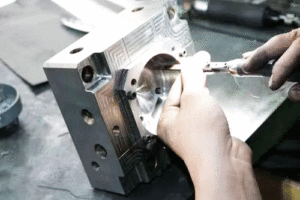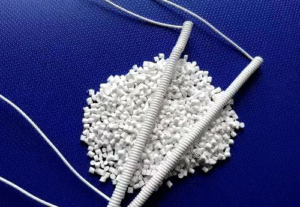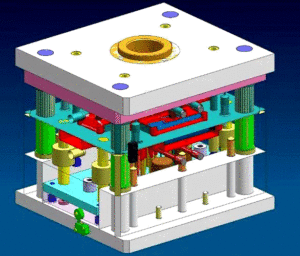
Polishing Treatment for Plastic Molds
Polishing Treatment for Plastic Molds With the widespread application of plastic products, such as daily-use items and beverage packaging containers, there is often a requirement
Surface Treatment of Plastic Products primarily includes Coating and Plating Processes.
Typically, plastics have high crystallinity, low or non-polar properties, and low surface energy, which can affect the adhesion of coatings. As plastics are non-conductive insulators, they cannot be directly plated according to standard electroplating processes. Therefore, prior treatment is necessary to enhance the adhesion of coatings and provide a conductive underlayer with good adhesion for plating processes.

Pre-treatment involves degreasing the plastic surface, which means cleaning the surface from oils and release agents, as well as activating the plastic surface to enhance adhesion for coating.
Similar to the degreasing of metal products, the degreasing of plastic products can be done using organic solvents or alkaline aqueous solutions containing surfactants. Organic solvent degreasing is suitable for removing waxes, paraffins, fats, and other organic contaminants from the plastic surface. The organic solvent used should not dissolve, swell, or crack the plastic. It should have a low boiling point, be easily volatile, non-toxic, and non-flammable.
Alkaline Aqueous Solutions for Degreasing are suitable for alkali-resistant plastics. These solutions contain sodium hydroxide, alkaline salts, and various surfactants. The most commonly used surfactants are from the OP series, namely alkylphenol polyoxyethylene ether, which does not form foam and does not leave residues on the plastic surface.
This activation aims to enhance the surface energy of plastic by creating polar groups or roughening the surface, making it easier for coatings to wet and adhere to the components. There are several methods for surface activation treatment, such as chemical oxidation, flame oxidation, solvent vapor immersion, and corona discharge oxidation.
The most widely used method is chemical chromic acid treatment. A typical formulation for this method consists of potassium dichromate 4.5%, water 8.0%, and concentrated sulfuric acid (96% or higher) 87.5%.
For some plastic products, such as polystyrene and ABS plastics, they can be directly coated without chemical oxidation treatment.
In order to obtain high-quality coating, chemical oxidation treatment is also used. For example, after degreasing ABS plastic, a diluted chromic acid treatment solution can be used, with a typical formulation of 420g/L of chromic acid and 200ml/L of sulfuric acid (specific gravity 1.83). The typical treatment process is at 65°C to 70°C for 5 to 10 minutes, followed by thorough rinsing and drying.
The advantage of using a chromic acid treatment solution for immersion is that it can uniformly treat plastic products of any shape, no matter how complex. However, the drawback is that it involves dangerous operations and potential pollution issues.

The purpose of pre-treatment for plating coating is to improve the adhesion between the coating and the plastic surface and to create a conductive metal base layer on the plastic surface.
The pre-treatment process mainly includes: mechanical roughening, chemical degreasing, chemical roughening, sensitization treatment, activation treatment, reduction treatment, and chemical plating. The first three are aimed at enhancing the adhesion of the coating, while the last four are for creating a conductive metal base layer.
Mechanical roughening and chemical roughening are methods that make the plastic surface coarser through mechanical and chemical means, increasing the contact area between the coating and the substrate. It is generally believed that the adhesion achieved by mechanical roughening is only about 10% of that achieved by chemical roughening.
The method of degreasing the plastic surface in the pre-treatment of coating before plating is the same as the method used in the pre-treatment of coating.
Sensitization involves adsorbing some easily oxidizable substances on the plastic surface with certain adsorption capacity, such as tin dichloride and titanium trichloride. These adsorbed easily oxidizable substances are oxidized during the activation treatment, and the sensitizer is reduced to form catalytic nuclei, which remain on the product surface. Sensitization lays the foundation for the subsequent chemical plating of the metal layer.
Activation involves treating the sensitized surface with a solution containing catalytically active metal compounds. In essence, products adsorbed with a reducing agent are immersed in an oxidant solution containing precious metal salts. The precious metal ions, acting as the oxidant, are reduced to form colloid-like particles deposited on the product surface, which exhibit strong catalytic activity. When such a surface is immersed in a chemical plating solution, these particles become catalytic centers, accelerating the reaction rate of the chemical plating.
After activation and thorough rinsing with water, the product is soaked in a solution of a certain concentration of reducing agent, which is used for chemical plating before chemical plating. This is done to remove any residual activator, and it is referred to as reduction treatment. For copper plating, formaldehyde solution is used for reduction treatment, while sodium hypophosphite solution is used for nickel plating.
The purpose of chemical plating is to create a conductive metal film on the surface of plastic products, providing the conditions for electroplating a metal layer on plastic products. Therefore, chemical plating is a critical step in plastic electroplating.

Polishing Treatment for Plastic Molds With the widespread application of plastic products, such as daily-use items and beverage packaging containers, there is often a requirement

Injection Molding Techniques for TPE and TPR Injection Molding Techniques for TPE and TPR 1. Dry the TPE and TPR material before injection molding It

Winter Maintenance Measures for Injection Molding Machines As winter approaches and temperatures gradually drop, a cold chill envelops the earth. While ensuring personal warmth, it

Assessment Regulations for Mold Trial Exceeding 3 Times Assessment Regulations for Mold Trial 1. Purpose The purpose of this regulation is to standardize the work of